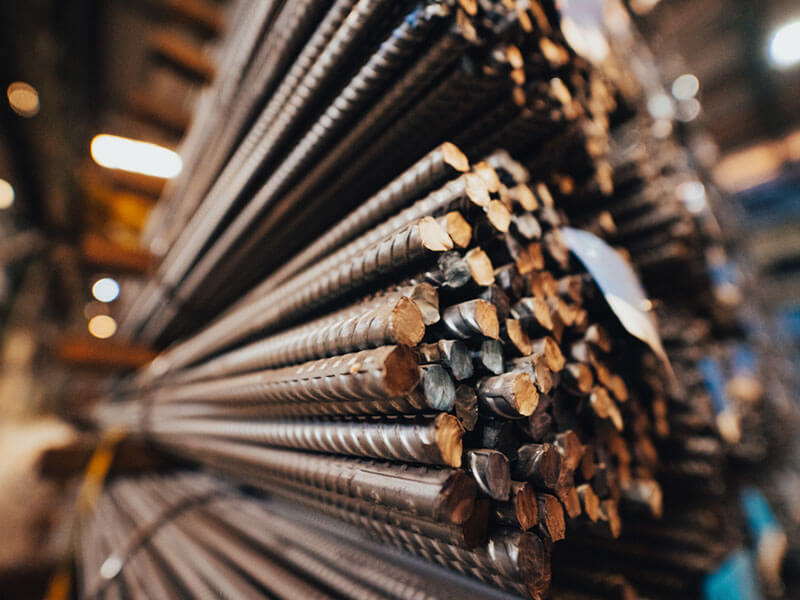
Steel is one of the most important materials in civil construction today. Besides being classified as a durable metal, it's highly versatile, coming in different types to meet specific construction needs. One of the most common is CA-60 steel.
Its correct use is essential to ensure greater resilience, support, and durability for a structure. Despite this, many people don't fully understand its qualities, how it's applied, or how it compares to other types of steel. This information is crucial for anyone planning a renovation or construction project, for example.
With that in mind, we've gathered the key information you need about CA-60 steel, including its main characteristics, how it compares to other similar types of steel, and its most commonly used applications. Stay tuned.
Steel, in general, is a metal alloy produced from iron and carbon, and may contain other elements. It is the presence and quantity of these "ingredients" that lead to the formation of the various types of steel used in construction.
CA-60 steel, in particular, is a low-carbon steel. Steels marked CA are the most commonly used in construction, being essential for most structures. They are typically supplied in the form of bars, rebars, or other materials. coils, depending on how they will be applied to the work.
As mentioned, there are several types of steel within the CA acronym, each followed by a number. Naturally, each has its own characteristics, which must be taken into account when planning a project.
Below, understand the main differences between CA-60 steel and other types of steel.
The number used in the nomenclature of each steel is indicative of the level of steel resistance. This resistance is measured in MPa, which stands for Mega Pascal, a standard unit of measurement for surface pressure.
The higher the number, the greater the pressure the material can withstand. 1 MPa would be equivalent to just over 10 kg of force per square meter of surface area. CA-25 steel can withstand 25 MPa, CA-50 50 MPa, and CA-60 60 MPa. In other words, CA-60 steel is the strongest of this group.
The different types of steel They can also have varying carbon levels in their composition, which affects some of their characteristics. CA-60 steel, in particular, is considered a low-carbon steel, meaning it has a carbon content of less than 0.3%.
Unless a part is already manufactured and cut to the exact shape, it often requires welding with other metals as part of the construction. This joining ensures a structure with the ideal shape for safe support.
A metal's weldability, in turn, is how easily it can be welded with other metals. The stronger this characteristic, the more efficient the process. And a notable feature of CA-60 steel is that it has better weldability compared to CA-50.
CA-60 steel is one of the main construction metals used today because of its high strength and weldability. Let's look at some of its main applications.
CA here stands for "Reinforced Concrete," meaning it represents a category of steel used in these structures. Bars and rebars are used to provide greater horizontal strength, while concrete increases vertical compressive strength.
Most Reinforced Concrete structures today in civil construction uses CA-60 or CA-50 steel, as they have high strength. However, in cases where it is necessary to weld rebar, CA-60 proves effective.
Another common application for this type of steel is in the formation of trusses. These are metal structures molded in a triangular shape, which provides greater strength with a smaller amount of material, making the structure lighter overall.
It is quite useful for developing steel skeletons for different structures, especially roofsThis saves materials and reduces construction risks. This, in addition to improving quality and protection, increases client satisfaction with the project's results.
In civil construction, slab is the name given to several structural elements of the work, which are flat and wide. Their function is to transfer the weight placed on their surface to the beams, avoiding excessive stress on a specific area.
Instead of building the slab directly on site, it's possible to use prefabricated slabs. These steel and concrete slabs can be fitted together on each floor, saving construction time. These structures are most commonly constructed using CA-60 steel, which is durable and easily welded.
It's also common to see many reinforced concrete pipes in certain construction projects, whether to control water flow or to protect other types of passages. They also require a steel frame to serve as a base. That's where CA-60 steel comes in.
When applied correctly, it provides greater strength to the structure, which is ideal for both facilitating transportation and increasing its functionality. This is important for structures located underground, where they are subject to great pressure and weight.
Now you understand a little better the main characteristics of CA-60 steel and how it compares to other types of steel used in reinforced concrete. With this information, you already have a foundation for planning certain projects, but it's always important to learn more and choose only high-quality steel for your construction projects.
Need quality steel for your project? Then check out our product catalog and request a quote with the Aço Cearense Group!